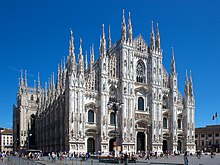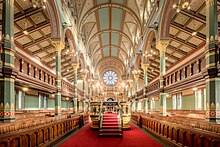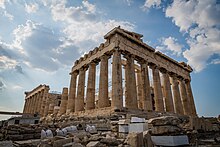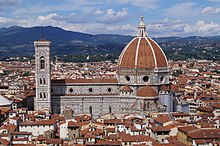Sacral architecture
Architect Norman L. Koonce has suggested that the goal of sacred architecture is to make "transparent the boundary between matter and mind, flesh and the spirit.[citation needed] The scholar of religious studies Florin George Călian affirms that "the sacred space is the place where the transcendent becomes immanent, and where the devotee can access God.Ancient religious buildings, particularly temples, were often viewed as the dwelling place, the temenos of the gods and were used as the site of various kinds of sacrifice.[citation needed] Ancient Egyptian religious architecture has fascinated archaeologists and captured the public imagination for millennia.[citation needed] The Parthenon, which served as a treasury building as well as a place for veneration of deity, is widely regarded as the greatest example of classical architecture.Indian architecture comprises a blend of ancient and varied native traditions, with building types, forms and technologies from West, Central Asia, and Europe.Originally, Viharas were temporary shelters used by wandering monks during the rainy season, but these structures later developed to accommodate the growing and increasingly formalized Buddhist monasticism.The architectural structure of the stupa spread across Asia, taking on many diverse forms as details specific to different regions were incorporated into the overall design.While the underlying form of Hindu temple architecture follows strict traditions, considerable variation occurs with the often intense decorative embellishments and ornamentation.[citation needed] The religious architecture of Christian churches in the Middle Ages featured the Latin cross plan, which takes the Roman basilica as its primary model with subsequent developments.Most architectural historians regard Michelangelo's design of St. Peter's Basilica in Rome as a precursor to the Baroque style;[citation needed] this can be recognized by broader interior spaces (replacing long narrow naves), more playful attention to light and shadow, extensive ornamentation, large frescoes, focus on interior art, and frequently, a dramatic central exterior projection.[opinion] St Paul's Cathedral in London by Christopher Wren is regarded as the prime example of the rather late influence of the Baroque style in England.The most influential modernist architects in the early to mid 20th century include Dominikus Böhm, Rudolf Schwarz, and Auguste Perret.The United States Air Force Academy Cadet Chapel, started in 1954 and completed in 1962, was designed by Walter Netsch and is an excellent example of modern religious architecture.The structure evokes the area's Hispanic heritage through the use of adobe coloring while combining stark modern form with some traditional elements.[9] Prayer halls contain no images of people, animals, and spiritual figures although they may be decorated with Arabic calligraphy and verses from the Qur'an on the walls.Sometimes, especially during Friday prayers, a raised minbar or pulpit is located to the side of the mihrab for a khatib or some other speaker to offer a sermon (khutbah).[12] These spiritual principles give rise to new forms of architectural expression that serve as spaces in which people of all beliefs, cultures, and backgrounds gather together, meditate, reflect, and pray, and around which will be built social, humanitarian, educational, and scientific institutions.[13] The design of each Bahá'í House of Worship reflects unifying elements of their environment, emerging from a grassroots approach of consultation with the native people,[14] each having nine sides and nine entrances, the number nine being symbolic of unity.













Sri Mariamman Hindu Temple, Singaporereligiousarchitecturalplaces of worshipchurchesstupassynagoguestemplesmonolithicbuildingsMilan CathedralGothicChristianityworshipprayermeditationPrinces Road SynagogueLiverpoolhistory of architectureBaroque periodSacred geometryiconographysemioticsTeotihuacánPyramid of the MoonRobert SchullerRichard KieckheferFlorin George CălianEgyptianLuxor TempleNeolithic architectureancient Egyptian architectureSumerian architecturetemenosTemple of KarnakParthenonAthensGreeceClassical architectureAncient Greek architectureAncient Roman architectureTemple of HeraOlympiaIndian rock-cut architectureHoysala architectureHindu temple architectureIndian architectureCentral AsiaEuropeBuddhist architectureToranaSanchiSouth AsiaBuddhismviharasmonasticismNalandaBuddhaMadhya PradeshchaityaAjantaElloraMaharashtrapagodaBuddhist templesMahabodhi TempleBodh GayaAranikoNepaliKublai KhanHindu architectureBrihadeeswarar TempleDravidianSthapatya VedaBrihat SamhitaVastu ShastraShilpa ShastrasVishvakarmaastronomytemplemacrocosmmicrocosmByzantine architectureHagia SophiaHoly WisdommosaicsJustinian IsquinchespendentivesChurch of the Intercession on the NerlMedieval architectureChurch architectureCathedral architectureMiddle AgesLatin crossbasilicatranseptscathedral diagramcathedralsByzantine styleGreek crossRussian orthodox architectureUrnes stave churchNorwaystave churchSainte-ChapelleGothic architectureGothic secular and domestic architectureabbey church of Saint-DenisSaint-DenisNotre-Dame de ParisCathedral of Our Lady of AmiensChartres CathedralFlorence CathedralRenaissance architectureRenaissanceFilippo BrunelleschiItalian Renaissance architectureSt Paul's CathedralBaroque architectureBaroqueMichelangeloSt. Peter's BasilicaSanta SusannaCarlo MadernoLondon



